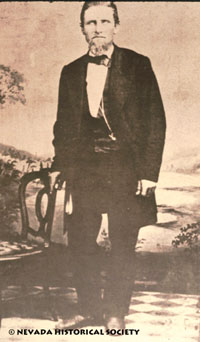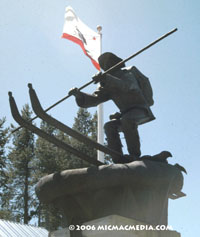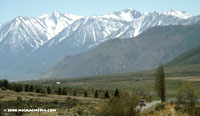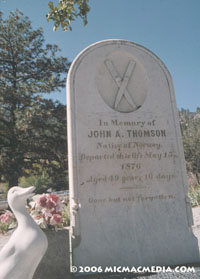 |
|
|
Follow Mark on Facebook for more stories |
||
|
Snowshoe Thompson: Out of all the skiers who have carved the slopes around Lake Tahoe, the most famous is undoubtedly John "Snowshoe" Thompson, the legendary skiing mailman of the Sierra Nevada. When it came to traveling in the wintry mountains, he was the precursor of the pack train, the stagecoach and the locomotive. It required years before any other form of transportation succeeded him.
After the Gold Rush, the increasing demand for communication between California and the eastern United States resulted in the establishment of an overland mail route between San Francisco and Salt Lake City. (The nation's first transcontinental railroad was still 18 years away.) The lucrative, but dangerous mail contract was worth $14,000 a year when George Chorpenning and Absolom Woodward took on the job in 1851. It took the men 16 days to pack the mail by mule 910 miles to the Great Salt Lake. They left Sacramento on May 1, but in order to cross the Sierra wooden mauls were needed to beat down the snow to create a trail for the heavily laden pack animals. It was exhausting work and became deadly when Indians killed Woodward in November 1851. During December 1851 and January 1852, Chorpenning tried to maintain the delivery, but brutal blizzards and deep snow in the Sierra turned him back. By February, the mail was rerouted up the Feather River Canyon and over Beckwourth Pass, but the detour increased the harrowing journey to 60 days, which proved too much for the men and animals. The following winter, the mail was shipped by steamer to Los Angeles and then packed eastward over the Old Spanish Trail through Arizona. The communities in western Utah Territory (present-day Nevada) were now effectively cut-off from any communication and supplies during the snowbound winter months. Newspapers published accounts of the dangerous difficulties and failed attempts to carry the mail over the mountains during the winter, but it seemed there was nothing anyone could do. In 1855 Thompson saw an ad published in the Sacramento Union: People Lost to the World: Uncle Sam Needs Carrier. The Placerville postmaster needed someone to carry the overland mail 90 miles east, up and over the Sierra range to the Carson Valley, in the dead of winter. There weren't any takers until Thompson, whose father had made him "snow-shoes" to ski to school as a child in Norway, decided to answer the call to duty. Web style snowshoes were common in the West, but only a few Scandinavian gold miners had begun sliding over the deep, powdery snow on long, hand-carved wooden boards. Precursor to the modern ski, these crude contraptions (often simply planks of wood salvaged from water barrels) were called snowshoes in the 19th century mining camps.
Thompson answered the ad and offered to haul the mail over the rugged High Sierra. No one in the region had seen skis before Thompson showed them his homemade long boards and single brake pole. On his first attempt from the snowline above Placerville over to the Carson Valley, his rucksack was packed with letters and packages. The hefty load weighed between 60 and 80 pounds. Initially Thompson's friends and neighbors feared that he would never survive the trek, but the skiing mailman conquered the hazardous journey east in just three days. The return trip up and over the Sierra's eastern escarpment took only 48 hours. Thompson's pack eventually exceeded 100 pounds when newspapers, medicine, and ore samples were stuffed into it. (The Virginia City Territorial Enterprise credited Snowshoe Thompson with accelerating the Comstock silver discovery and Nevada statehood because he carried the first ore samples to California to be assayed for value.) Other vital supplies he hauled included clothing, books, tools, pots and pans. He also carried the type and newsprint for Nevada's first newspaper, the Territorial Enterprise. At least twice a month for 20 years, Snowshoe Thompson hauled his heavy rucksack through the mountains. Fair skies or storm, rain or snow, Snowshoe Thompson always delivered. For personal protection, he carried only matches, some beef jerky, crackers and biscuits — no blanket, no gun, no camping gear or compass. He wore a simple Mackinaw jacket, a wide brimmed hat, and smudged his cheekbones with charcoal to prevent snow blindness. Thompson rarely stopped to rest and sometimes built a fire for heat, but when a blizzard made that impossible, he danced a jig on a flat rock to stay warm. Thompson preferred to ski at dawn and dusk when the snow was hard, crusted and very fast. He navigated in the dark using the stars as a compass and he judged his progress and elevation by observing rock formations along the route. In 1859, Thompson formed a partnership with Judge Childs of Genoa to operate a
sleigh line for passengers and express packages across the Sierra, The business utilized horses wearing custom snowshoes to pull the loaded sleds, but when severe
winter storms made the trip too dangerous, Snowshoe would go alone carrying the mail and supplies. The exploits of Snowshoe Thompson are one of Tahoe's greatest legends, but it is not mythology. Thompson rescued many people from certain death during his 20 years as mail carrier. One notable effort occurred in late December 1856, when Snowshoe discovered prospector James Sisson snowbound in the valley south of Lake Tahoe. For 12 days Sisson had been lying in a remote cabin without fire, both legs frozen and nothing to eat but raw flour. Snowshoe chopped wood, built a fire and assisted the miner as best he could before skiing off to get help in Genoa. He returned with six men who joined Thompson in hauling Sisson out by sled. The physician attending to Sisson's injuries in Genoa reported that he needed an anesthetic to perform an amputation in order to save the man's life. When Snowshoe heard that the vital chloroform could only be obtained in Sacramento, he grabbed his skis and started back up the mountain trail. He crossed the Sierra twice in his heroic journey, and returned with the anesthetic in time for the doctor to operate and save James Sisson's life. For a short time during the building of the transcontinental railroad over the Sierra, Snowshoe carried the mail from Cisco to Meadow Lake. Resident Clarence Wooster wrote that Thompson would "sail down his four-mile course at great speed, cross the ice frozen river, throw our mail toward the house, and glide out of sight, up and over a hill, by the momentum gathered in the three mile descent."
Over the years, Snowshoe tried to charge $1 per letter carried, but some people wouldn't pay and demanded their mail anyway. For years he was promised proper compensation by local authorities, but nothing ever came of it. Thompson was a good Samaritan and somewhat naive in the ways of government. Initially he was happy to do the job, but when he got married and his son was born, he needed money to raise his family. Trusting in the goodwill of people and his new country, Thompson did not sign a contract with the U.S. Postal Service, but he wasn't worried and said, "If I do my job and get the mail to the people, Uncle Sam will pay me." Unfortunately, despite his political contacts and an 1869 appeal by the Nevada Legislature to the federal government for $6000 in compensation, Thompson was never paid. Not willing to give up, in 1872 Thompson traveled to Washington, D.C. to lobby for what he felt was his deserved compensation. On the way, the train got stuck in snowdrifts. Getting impatient, he started off walking through the snow carrying his suitcase. After three days, he reached Cheyenne, Wyoming where he got another train, which took him to the nation's capital. He was the first man in two weeks to come directly from the Pacific Coast and newspapers back East hailed him as the first person to beat the Iron Horse over such a long distance. Thompson waited for six weeks in Washington waiting for the Congressional Committee to decide on his request, but he ran out of money and had to return home before they did. He blamed no one but himself for not getting paid; realizing he never had an official mail contract with the U.S. Postal Service. The political snub resurrected itself again in the 1990s when the Smithsonian Institute failed to include Snowshoe Thompson in its exhibit chronicling the history of the Postal Service, once again because he had not signed a contract.
Monuments and statues to the memory and heroic efforts of Snowshoe Thompson abound, and can be found at Boreal Ski Resort on Donner Pass, at Genoa, Nevada, in the Squaw Valley Village, and on Highway 88 along one his mail routes. His feats of skill and daring may be legendary, but John "Snowshoe" Thompson's heart was truly bigger than life. Genoa Postmaster S.A. Kinsey wrote, "Most remarkable man I ever knew, that Snowshoe Thompson. He must be made of iron. Besides, he never thinks of himself, but he'd give his last breath for anyone else – even a total stranger." |
|||||||||||||||||||||||
|




